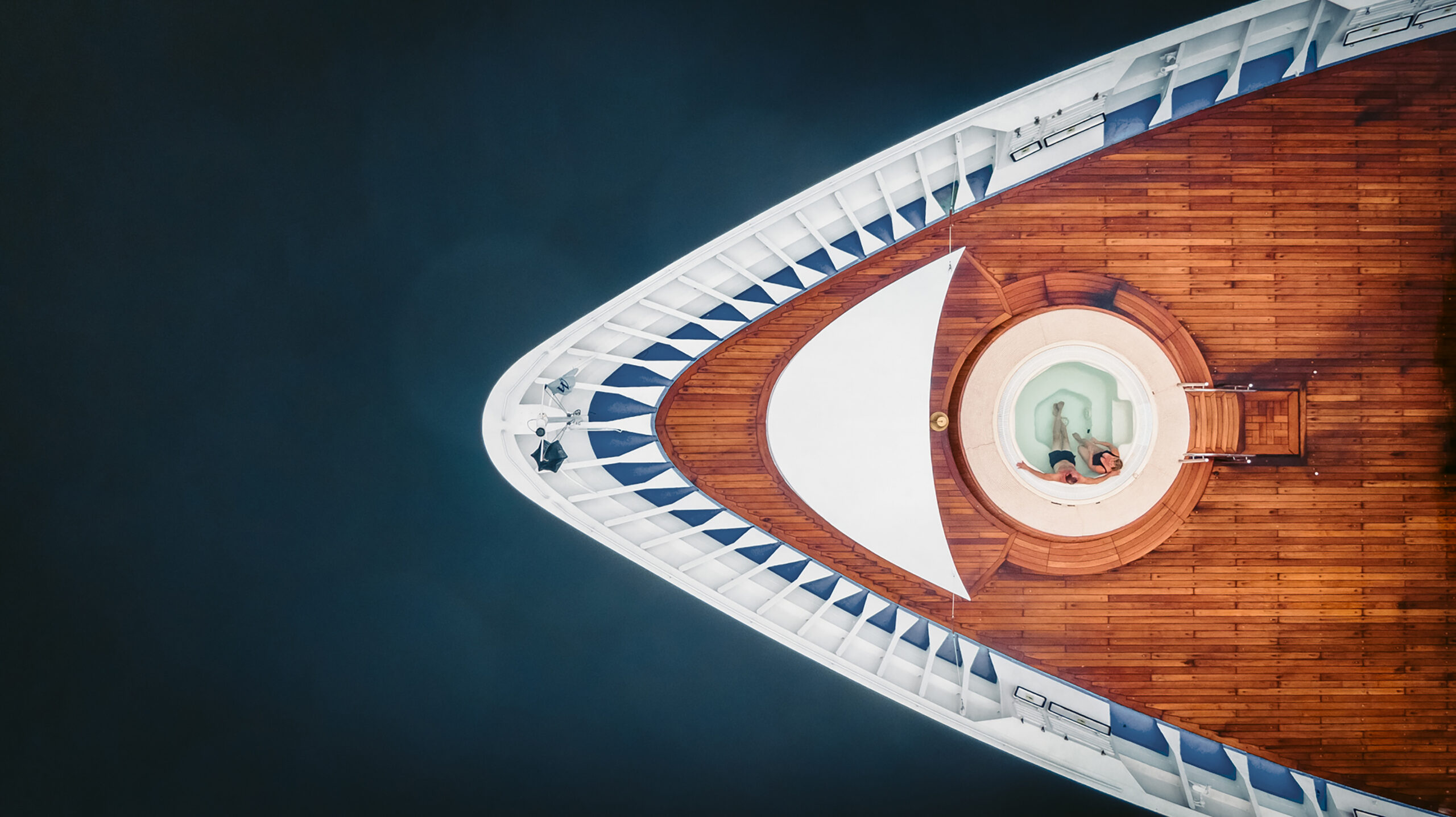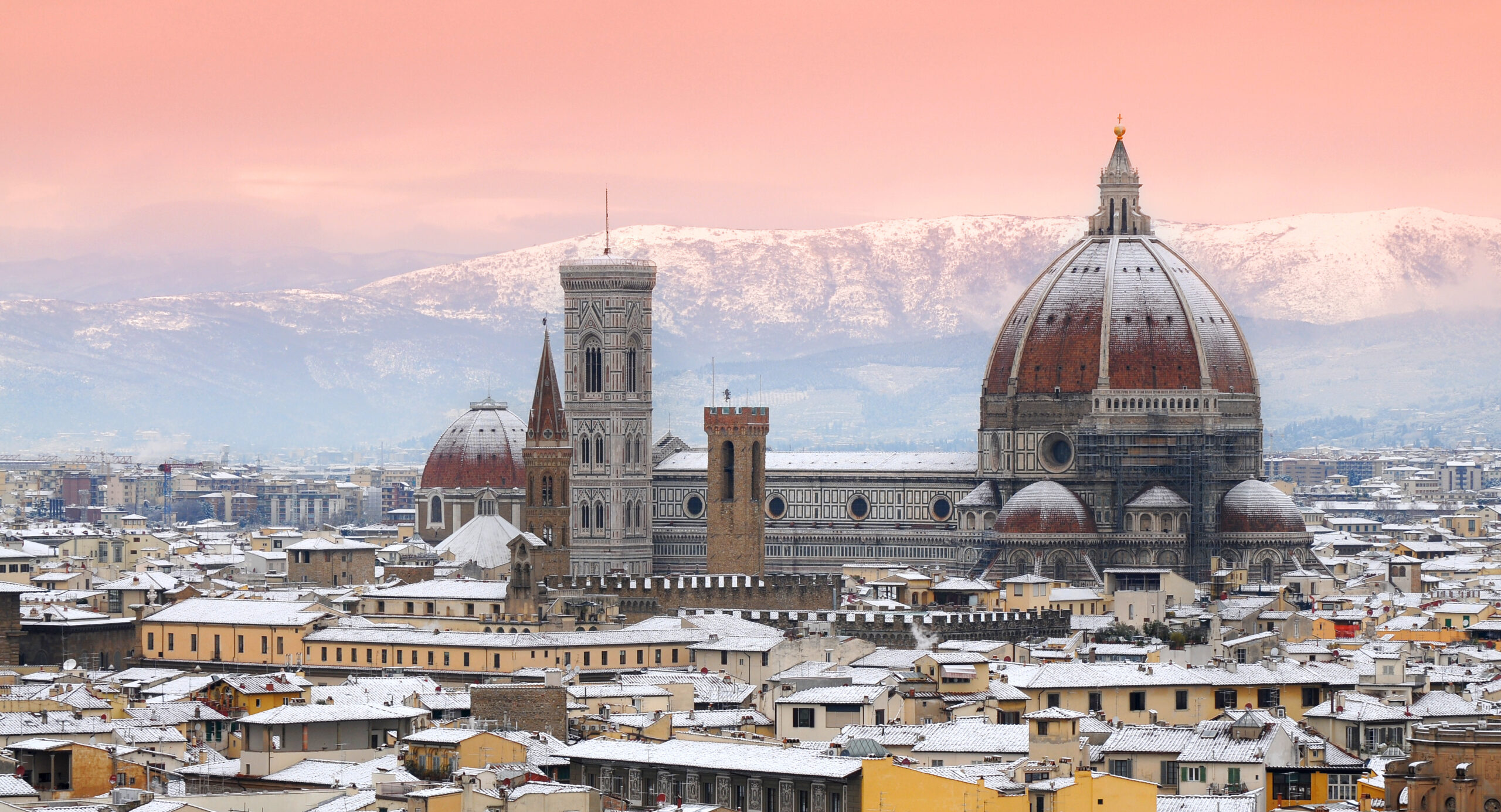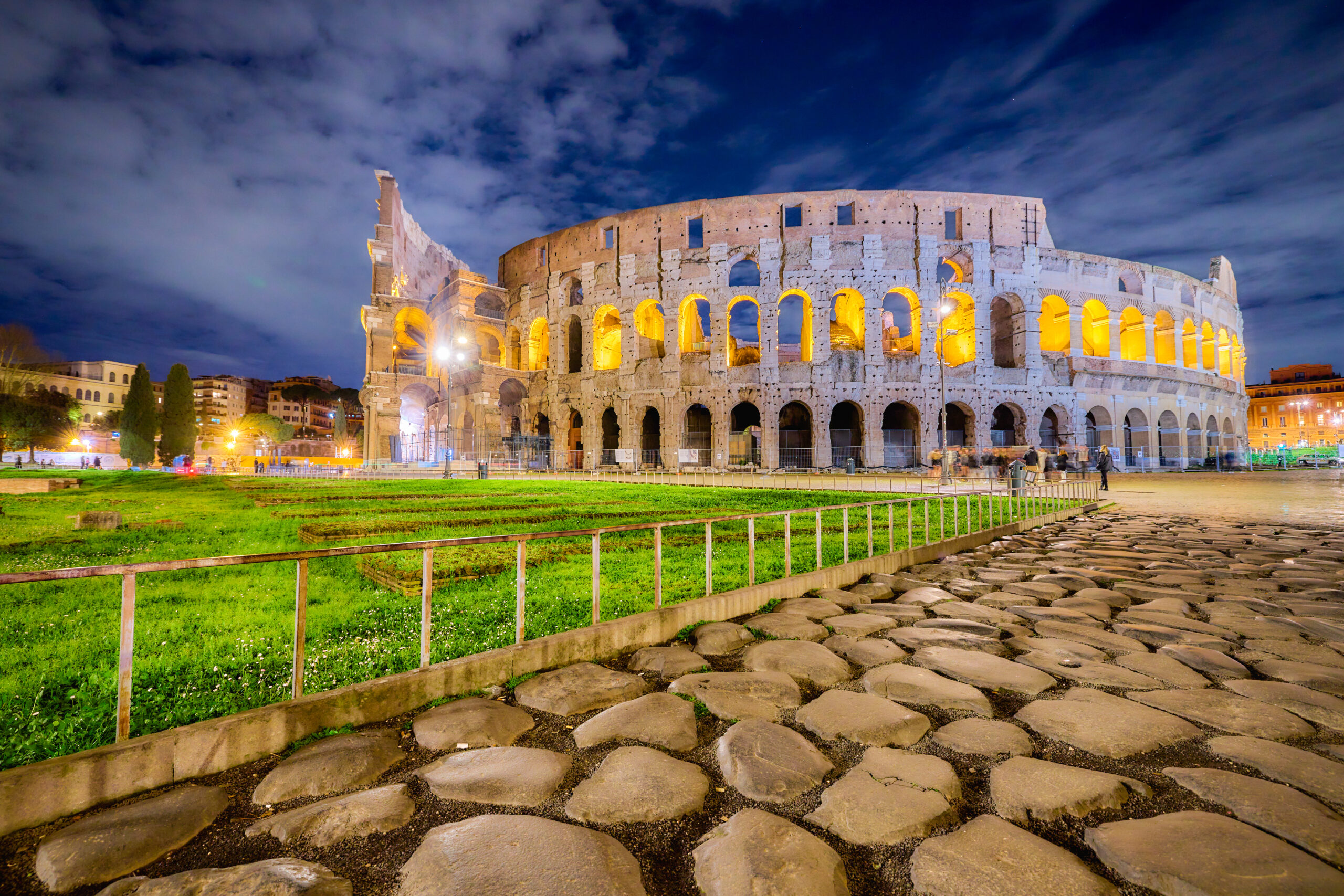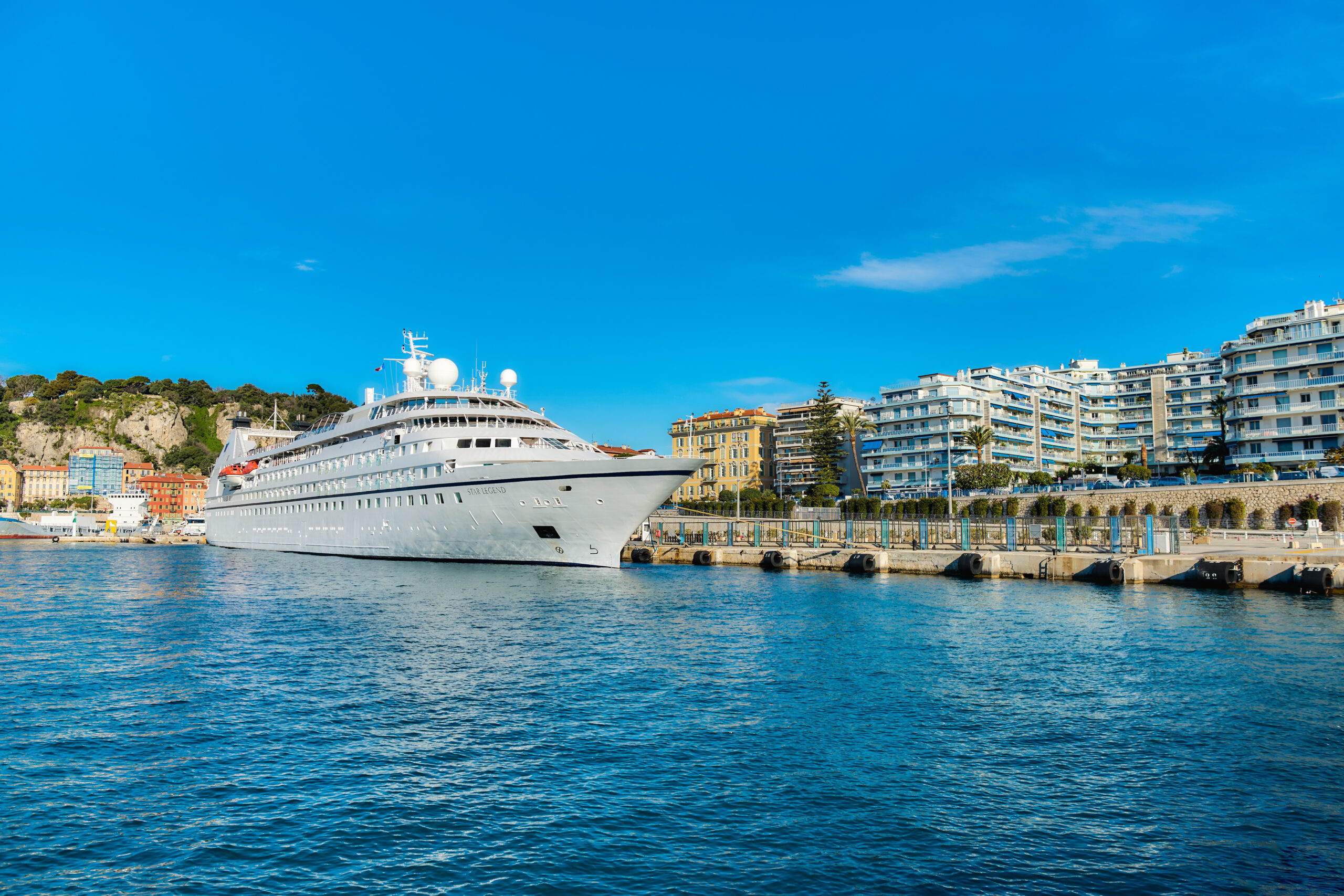On a Mediterranean sail from Barcelona to Rome, Nicole and Rebecca discovered cruising is the ultimate two-itinerary trip.
Words by Nicole Letts & Rebecca Deurlein
Photos by Windstar Cruises
As an avid BBC fan long before the days of Downton Abbey and Peaky Blinders, I [Nicole] have been taunted by commercials for European river cruises. The promises of a small ship, extraordinary views, and enchanting destinations piqued my interest, and that vacation style became my bucket list endeavor. When Rebecca suggested Windstar Cruises, a line with luxury yachts serving between 100 and 350 guests, I jumped at the opportunity to cruise with them. We settled on Europe’s Winter Riviera itinerary, which embarked from Barcelona and made stops in cities that included Nice, France; Genoa; and Livorno, Italy, before docking in Rome.
Once aboard, we found that the benefits of French Riviera cruising far outweighed other transportation options. We were able to unpack our bags in our spacious, respective cabins, always have a seat at a table for dinner, and get to know other passengers during excursions and other activities. During days at sea, we opted for leisurely mornings in the Yacht Club, relaxing treatments in the spa, and abundant meals in various restaurants. The attentive staff anticipated our every need: a fruit basket filled with our favorite items was replenished daily, and our preferred wine arrived at our table before we even asked. Questions about activities and excursions were always promptly answered. It was a comforting way to see unfamiliar cities, and we felt cared for the entire way.
Rebecca and I agree that cruising is one of the best possible options for traveling with friends, coworkers, or loved ones who might not share the same interests. More days than not, we were off doing our own sightseeing, coming together in the evenings over meals to excitedly share our adventures. It made for a smooth trip with shared memories.

Nicole’s Itinerary
Shopping in Florence (and Nice and Rome)
Having been to Florence, Italy, in my early twenties to take in the must-see sites like the Cathedral of Santa Maria del Fiore and Galleria dell’Accademia, where Michelangelo’s perfect man, David, stands, I knew I wanted to reserve this trip to Florence for something different: shopping. Florence is best known for its high standards for leather and gold. Leather production in Florence dates back to the Etruscan era, with the “Arte dei Cuoiai” (leatherworkers guild) established in the 13th century, and once fashion houses like Gucci and Salvatore Ferragamo planted roots in the city, its reputation for leather continued to rise.
My cabin mate for the week was my lifelong friend, Erin (who also had Rebecca as an English teacher in high school), and we had our sights set on a few key Florentine purchases. Windstar offered a Florence On Your Own excursion, which provided coach transportation and a guide for a day in the city. Our guide was able to point us to two incredible shops for gold and leather.
Coi has specialized in jewelry since 1954, and its showroom near the Ponte Vecchio makes it a convenient spot for shopping. The showroom specialists are patient and knowledgeable, and Erin and I both spent over an hour trying on various pieces before settling on a few to bring home. After Coi, we made our way to Atelier Michelangelo near the Basilica of Santa Croce. The shop largely features items made at the leather school on-site including bags, jackets, and other small goods. We were both fitted for cashmere-lined leather gloves that were embossed with our initials on the spot.
Candidly, the shopping didn’t end in Florence. We were especially delighted with a trip to a pharmacie in France where we loaded up on skincare, and I was smitten by a few shops in Rome, namely Schostal, known for its 100% cotton pajamas.
Cruising is one of the best possible options for traveling with friends, coworkers, or loved ones who might not share the same interests.
Dining Michelin Style
My number one tip for dining abroad is to download the Michelin app and use it to guide you to some of the highly revered (but not starred) restaurants such as those designated as Bib Gourmand. Thanks to some savvy research, Erin and I were able to snag the only walk-in table at Rosmarino, a Ligurian trattoria in Genoa. Don’t be turned off by the restaurant’s proximity to the bustling Piazza de Ferrari. Make your way down a cobblestone alley as the noise dissipates in the background. Rosmarino is small, and most of its tables are by reservation only, so if it’s a must-do (and it should be), plan ahead.
Everything at Rosmarino—focaccia, pesto, pasta, pastries, and sorbet—is made by hand. We trusted server and maître d’ Eugene to guide our meal, which he wisely did, suggesting the restaurant’s signature dishes and regional wines. Artichoke flan with local cheese fondue led to brandacujun, a Ligurian specialty made with cod and potatoes, which flowed into pesto “Genoese style” lasagna with beef and pork ragout, before being punctuated with passiti wine and cookies for dessert. The meal was the highlight of my time in Genoa, and for the remaining six days of the trip, it was hard to find one that matched its level of refinement and enjoyment.
Exploring Beyond the Guidebooks
One of the many perks of cruising with Windstar is the abundant, unique excursions. Rebecca and I enjoyed cava wine tasting in Barcelona, and we each took various day trips to other locales. One of my most cherished outings, however, was truffle hunting in San Miniato, hosted by Savani, a renowned truffle company.
We joined our guide and his dog, Ombra (Shadow) for the hunt through a shady forest. With her nose attentively on the ground, Ombra dashed from tree to tree sniffing its base for truffles, and she was rewarded with treats (and ample pets) upon her discoveries. Once the hunt was complete, our group dined on a three-course meal featuring truffles served in various ways.
Experiences like these are not written about in every guidebook, and I made it a point to seek those opportunities in as many cities as I could throughout the trip. In Florence, I made my way to the Ferragamo Museum, located on the garden level of the brand’s flagship store. Here, I learned the history of the company while taking in a selection of its archive. In Rome, Erin and I took a tuk-tuk tour that promised (and succeeded! ) to show us all of Rome in just three hours. Did we look like American tourists? Yes, we did. Did we see every possible major point of interest and laugh hysterically while doing so? Yes, we did.


Rebecca’s Itinerary
Going Medieval in Eze
It’s the city with the weirdest name, yet I hadn’t heard of it until it was offered as a Windstar excursion in Nice. A quick Google search revealed a medieval village that reminded me of Mont Saint-Michel – another one of those off-the-beaten-path French towns that is worth the drive. Arriving in January was a boon. Because Eze is so adorably quaint, it is usually filled to the brim with visitors, but winter brings a quiet, relaxed vibe. When I say our small group had the entire village to ourselves, I mean it.
Cobblestone streets, narrow alleyways that disappear around curves, stone structures covered in ivy, archways draped in vines, bougainvillea tumbling over tiered walls, pastel buildings with painted wood shutters, and ornately curved iron lanterns—every inch of this tiny town is a delight. You’ll find café tables perched on landings with sweeping views of the Cote d’Azur and Monaco. There you can take a breather from the gentle uphill slope, sip a cappuccino, and contemplate life in the French Riviera. I can’t stress this enough—keep climbing to the top, where you’re rewarded with the Exotic Garden of Eze, a multi-tiered showcase of hundreds of varieties of succulents, including fiery red blooming aloe, positively stunning against the azure Mediterranean Sea. A tall statue of a female carrying a basket of buds blends perfectly with an even taller cereus cactus. Pause to take in the colorful tiled roofs of Eze, the aerial view of the winding walkway, and the 360-degree vistas of the gorgeous French landscape.
Finding Little-Known Lucca
Some of life’s greatest pleasures come from unexpected places. I had no intention of visiting Lucca…until my foodie excursion was canceled and I was left trying to salvage the day. That’s when my husband and I decided to hire a taxi driver to take us to the Tuscan town of Lucca, a place a fellow passenger had raved about at dinner the night before. I had never heard of it. My research produced more about its neighbor, Pisa (where buildings go to lean), than about the much more substantial Lucca. But our taxi driver was enthusiastic, offering up a map, dropping us in the town piazza, and agreeing to hang out until we were ready to go.
Wandering the streets of Lucca is a pleasure—the small size makes it manageable, so you can easily spend a few hours exploring. The rounded buildings of Piazza dell’Anfiteatro follow the footprint of a former Roman amphitheater and are an imposing backdrop to tiny restaurants and flamboyant street performers. Behind it, 16th-century fortifications loom, a reminder that this was once a walled city. Today, you can walk or bike atop the walls, following in history’s footsteps and gazing down at the buildings and people below. From there, you’ll notice that this “City of 100 Churches” comes by its name honestly. My favorite was Chiesa di San Michele in Foro, with its beautifully classic façade—I was shocked to discover its simple interior with gray stone walls and a single crucifix at the altar. It was refreshingly “real,” a reminder that beauty can also be starkly simple.
Some of life’s greatest pleasures come from unexpected places.
We even stopped in Pisa on our return—our driver positively insisted. If I’m being honest, I’m glad he did. We snapped some photos and found the city to be quite charming. There’s much more to Pisa than its leaning tower, so it’s definitely worth checking out.
Roaming Incredible Rome
Ah, Rome. I was afraid you’d be too old, too dirty, and too steeped in history to interest this outdoor adventurer. I’ve never been happier to be wrong. I loved Rome, all the historical remains, every fountain, every 10,000 steps logged. The only city I can compare it to is Athens, and even that’s a stretch. Rome is cleaner, more walkable, and more tourist-friendly than its Greek counterpart. It knows who it is and what people love about it, and it works hard to make you a believer. My first view of the Trevi Fountain is one I’ll never forget. The same goes for the Roman Forum, the Colosseum, and St. Peter’s Basilica. Yes, they’re all heavily visited tourist spots, and yes, for very good reason. But luckily, Rome in January is much less crowded than Rome in July, so I was able to see and do it all without jostling for space or fighting for a great photo.
I took no guided tours in Rome. Instead, I wandered, stopping to make sure that my man got his “authentic pizza,” “authentic pasta,” and “authentic gelato.” He devoured them all with glee. We may have missed out on fantastic historical facts from a trusty guide, but it was so much fun to stumble upon the Piazza Navona and its three famous fountains, all major players in one of my favorite novels of all time, Dan Brown’s Angels & Demons. I taught the book for years, so seeing the fountains in person—especially Bernini’s Four Rivers Fountain—was a special treat.
As was every city on this trip, something only a cruise could have made possible. There’s something to be said for ending a long day with cocktails and conversations, then waking up in a new city ready to do it all again.
Where to stay pre- and post-cruise
Barcelona –Majestic Hotel & Spa
Winner of multiple #1 awards, the five-star Majestic can’t be beaten in any category. It’s located in Barcelona’s most exclusive neighborhood along Passeig de Gràcia, just steps away from Gaudi monuments and the famous Rambla. Chef Nandu Jubany oversees all the hotel’s dining venues: the rooftop La Dolce Vitae, the farm-to-table SOLC, El Bar del Majestic, and the Sunday brunch experience, all paying homage to traditional Catalan foods. Bonus: The hotel offers private car service from the airport and to your cruise port.
Rome – The Hotel de la Ville
At the top of the Spanish Steps, this luxury, 18th-century palazzo manned by smartly dressed doormen offers picturesque city views from private terraces. It’s just a 10-minute walk to the Trevi Fountain and fantastic, al fresco dining. But the real gems here are the concierges—they happily recommend under-the-radar restaurants, take care of reservations, secure tickets, and generally make themselves indispensable. Note: The cruise port is about 90 minutes from the hotel, so be sure to book a transfer through your cruise. Otherwise, the train is convenient, quick, and very affordable, and it takes you straight to the center of Rome—you can walk to your hotel from there.


